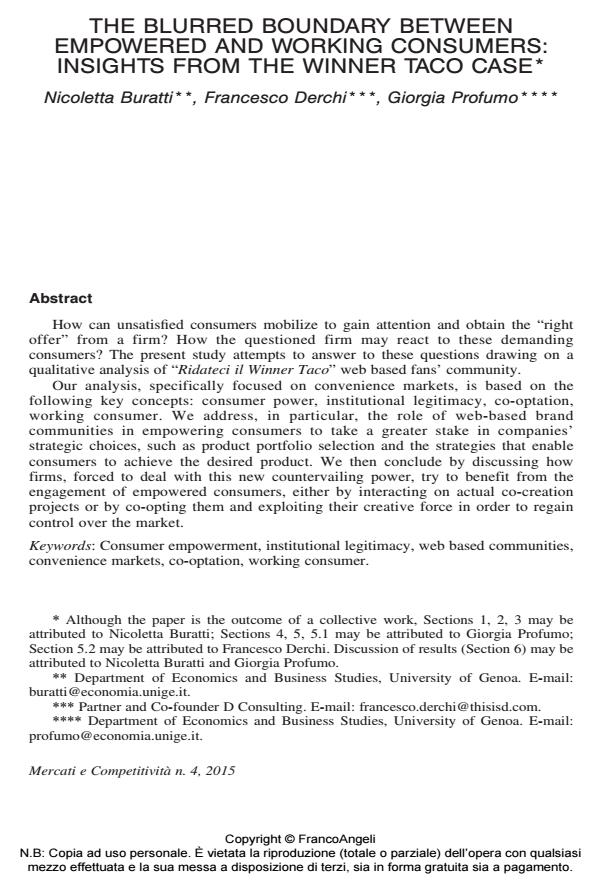The blurred boundary between empowered and working consumers: insights from the winner taco case
Titolo Rivista MERCATI E COMPETITIVITÀ
Autori/Curatori Nicoletta Buratti, Francesco Derchi, Giorgia Profumo
Anno di pubblicazione 2015 Fascicolo 2015/4
Lingua Inglese Numero pagine 24 P. 133-156 Dimensione file 170 KB
DOI 10.3280/MC2015-004007
Il DOI è il codice a barre della proprietà intellettuale: per saperne di più
clicca qui
Qui sotto puoi vedere in anteprima la prima pagina di questo articolo.
Se questo articolo ti interessa, lo puoi acquistare (e scaricare in formato pdf) seguendo le facili indicazioni per acquistare il download credit. Acquista Download Credits per scaricare questo Articolo in formato PDF

FrancoAngeli è membro della Publishers International Linking Association, Inc (PILA)associazione indipendente e non profit per facilitare (attraverso i servizi tecnologici implementati da CrossRef.org) l’accesso degli studiosi ai contenuti digitali nelle pubblicazioni professionali e scientifiche
How can unsatisfied consumers mobilize to gain attention and obtain the "right offer" from a firm? How the questioned firm may react to these demanding consumers? The present study attempts to answer to these questions drawing on a qualitative analysis of "Ridateci il Winner Taco" web based fans’ community. Our analysis, specifically focused on convenience markets, is based on the following key concepts: consumer power, institutional legitimacy, co-optation, working consumer. We address, in particular, the role of web-based brand communities in empowering consumers to take a greater stake in companies’ strategic choices, such as product portfolio selection and the strategies that enable consumers to achieve the desired product. We then conclude by discussing how firms, forced to deal with this new countervailing power, try to benefit from the engagement of empowered consumers, either by interacting on actual co-creation projects or by co-opting them and exploiting their creative force in order to regain control over the market.
In che modo i consumatori insoddisfatti si mobilitano per catturare l’attenzione di una impresa ed ottenere ciò che desiderano? Come l’impresa sfidata reagisce a tali richieste? Il presente studio si propone di rispondere a queste domande basandosi su una analisi qualitativa della comunità web di appassionati "Ridateci il Winner Taco". La nostra analisi, focalizzata sui mercati dei prodotti di largo e generale consumo, si basa su alcuni concetti chiave: empowerment dei consumatori, legittimazione istituzionale, cooptazione, working consumer. In particolare, intendiamo approfondire il ruolo che le comunità di marca create sul web giocano nel processo di accrescimento del potere del consumatore, fino a consentirgli di condizionare alcune scelte strategiche dell’impresa, come ad esempio la selezione del portafoglio prodotti, per ottenere ciò che ritengono l’irrinunciabile oggetto del desiderio. Il lavoro si conclude mettendo in luce come le imprese, a fronte di tale potere, tentino di trarre beneficio dal coinvolgimento del consumatore empowered, attraverso percorsi non privi di ambiguità: da un lato infatti possono puntare al coinvolgimento dei consumatori più attivi in autentici progetti di co-creazione, dall’altro possono tentare di cooptarli, sfruttando il loro attivismo e la loro creatività per riguadagnare il controllo del mercato.
Parole chiave:Empowerment dei consumatori, legittimazione istituzionale, comunità web based, mercati convenience, cooptazione, working consume
- Technological innovation and marketing. a multi-perspective analysis Nicoletta Buratti, Riccardo Lanzara, Michele Simoni, in MERCATI E COMPETITIVITÀ 1/2016 pp.19
DOI: 10.3280/MC2016-001003 - Brand negotiation and brand management. An actor-network theory perspective Agostino Vollero, Daniele Dalli, Alfonso Siano, in MERCATI & COMPETITIVITÀ 4/2016 pp.23
DOI: 10.3280/MC2016-004003
Nicoletta Buratti, Francesco Derchi, Giorgia Profumo, The blurred boundary between empowered and working consumers: insights from the winner taco case in "MERCATI E COMPETITIVITÀ" 4/2015, pp 133-156, DOI: 10.3280/MC2015-004007